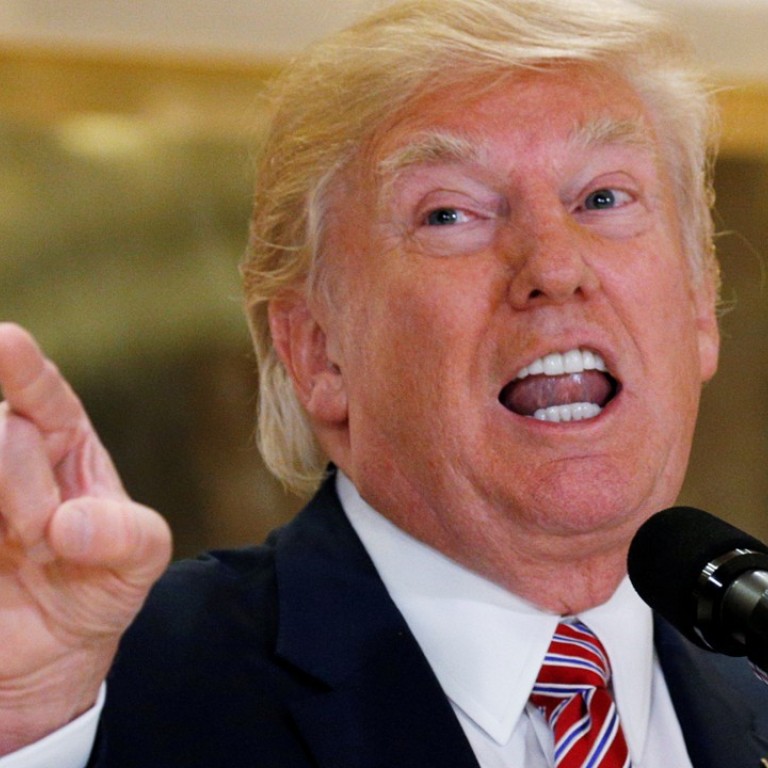
‘What about the alt-left’: Trump again blames ‘both sides’ for deadly violence in Virginia
Former leader of Ku Klux Klan applauds Trump for his ‘courage’
Combative and insistent, President Donald Trump declared anew on Tuesday “there is blame on both sides” for the deadly violence last weekend in Charlottesville, Virginia, appearing to once again equate the actions of white supremacist groups and those protesting them.
The president’s comments effectively wiped away the more conventional statement he delivered at the White House a day earlier when he branded members of the KKK, neo-Nazis and white supremacists who take part in violence as “criminals and thugs.”
Trump’s advisers had hoped those remarks might quell a crush of criticism from both Republicans and Democrats. But the president’s retorts on Tuesday suggested he had been a reluctant participant in that clean-up effort.
During an impromptu press conference in the lobby of his Manhattan skyscraper, he praised his original response to the Charlottesville clashes and angrily blamed liberal groups in addition to white supremacists for the violence. Some of those protesting the rally to save a statue of Confederate General Robert E Lee were “also very violent,” he said.
“There are two sides to a story,” he said. He added that some facts about the violence still aren’t known.
Trump’s core supporters have sought to blame Black Lives Matters activists and anti-fascist protesters known by the far-right as “antifa,” for the violence, and Trump delivered with relish.
“What about the alt-left that came charging at the, as you say, the alt-right?” Trump said. “Do they have any semblance of guilt?”
His remarks were welcomed by former Ku Klux Klan leader David Duke, who tweeted: “Thank you President Trump for your honesty & courage to tell the truth about #Charlottesville & condemn the leftist terrorists in BLM/Antifa”
Trump’s handling of the weekend violence has raised new and troubling questions, even among some supporters, about why he sometimes struggles to forcefully and unequivocally condemn white supremacist groups.
Members of his own Republican Party have pressured him to be more vigorous in criticising bigoted groups, and four business leaders have resigned from a White House jobs panel in response to his comments.
Democrats were aghast at Trump’s comments Tuesday.
Virginia Senator Tim Kaine said on Twitter that “Charlottesville violence was fueled by one side: white supremacists spreading racism, intolerance & intimidation. Those are the facts.”
Senator Brian Schatz of Hawaii said on Twitter that ”this is not my president”.
“As a Jew, as an American, as a human, words cannot express my disgust and disappointment,” he wrote.
Violence broke out Saturday in Charlottesville, a picturesque college town, after a loosely connected mix of white nationalists, neo-Nazis and other far-right extremists assembled to protest the city’s decision to remove a towering statue of Confederate general Robert E Lee.
Heather Heyer, 32, was killed when a man ploughed his car into a crowd of counter-protesters.
Trump appeared to defend both the extremists’ right to protest, noting they had a permit, and Confederate statues.
“So, this week it’s Robert E Lee,” he said. “I noticed that Stonewall Jackson’s coming down. I wonder, is it George Washington next week and is it Thomas Jefferson the week after? You really do have to ask yourself where does it stop?”
As Trump talked, his aides on the sidelines of the lobby stood in silence.
Chief of staff John Kelly crossed his arms and stared down at his shoes, barely glancing at the president. Press secretary Sarah Huckabee Sanders looked around the room trying to make eye contact with other senior aides. One young staffer stood with her mouth agape.
When asked to explain his Saturday comments about Charlottesville, Trump looked down at his notes and again read a section of his initial statement that denounced bigotry but did not single out white supremacists. He then tucked the paper back into his jacket pocket.

Trump, who has quickly deemed other deadly incidents in the US and around the world acts of terrorism, waffled when asked whether the car death was a terrorist attack.
“There is a question. Is it murder? Is it terrorism?” Trump said. “And then you get into legal semantics. The driver of the car is a murderer and what he did was a horrible, horrible, inexcusable thing.”
Trump said he had yet to call Heyer’s mother, said that he would soon “reach out.” He praised her for what he said was a nice statement about him on social media.
As Trump finally walked away from his lectern, he stopped to answer one more shouted question: Would he visit Charlottesville? The president’s response was to note that he owned property there and said it was one of the largest wineries in the United States.

